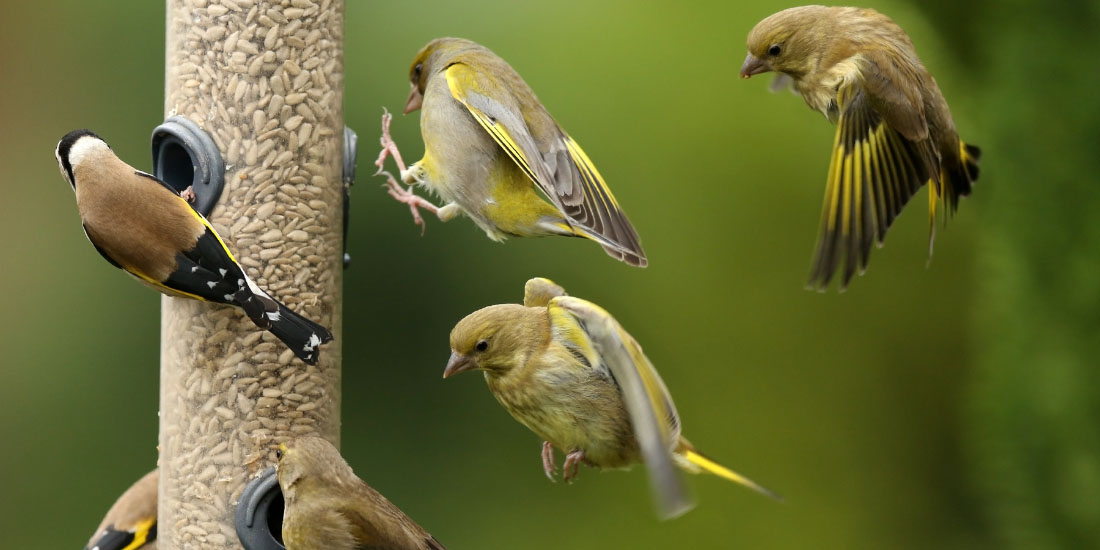How do you start feeding birds?

According to the 2021 RSPB national garden survey, 38 million birds have been lost from UK skies in the last 50 years. Food availability is just one of the factors impacting the decline, but by creating a welcoming and safe feeding environment you can help make a difference.
Regardless of the size of your garden or outdoor space, there is always an opportunity to attract more birds and our how to start feeding birds guide shares tips to help you attract more birds to your garden. With this in mind, there are three important factors to consider when beginning to feed birds: the type of bird food, the feeder, the location of the feeders and advice for keeping them clean.
Start by picking the right food mix for feeding birds
Knowing what to feed birds can be a little daunting at first glance, especially with such a large selection of bird food available. But ideally, you want to try to replicate their natural diet of seeds, fruits, and nuts that they eat naturally. We guarantee our mixes are of the highest quality and are filler-free - meaning there are no added extras to bulk out the mix to make the bag heavier (like many other bird food companies do!). If you're unsure, it's best to pick a bird food mix since it will attract more bird species and provide them with the necessary nutrients.
Picking the right bird food for feeding birds
Everyday Essentials is a filler-free mix and provides a balanced blend of all necessary nutrients, such as proteins, carbohydrates and fats. Ingredients like groats and white millet are slow-releasing carbs that will keep birds energised for longer. With both husked and non-husked seeds, it will encourage a wider variety of birds to your feeder. Likewise, our Four Season Feast keeps wild birds full and energised all year round.
We also have seasonal mixes available, like our Winter Wellness, which is high in fat and rich in oils, providing a vital energy source to help birds through challenging weather. Summer Glow is the perfect mix of proteins, oils and fats that will keep birds well fuelled for flying and foraging during the warmer months.
For more experienced bird feeders or if you wish to attract a certain species of bird, then straight foods are a great option. Niger seeds are rich in oils and are a favourite of the finch family and other small-beaked birds due to their size. A peanut-only feed will encourage more tits, finches and sparrows to your garden and is packed full of protein and fats, making it a popular choice all year round.
Consider what types of feeders are ideal when feeding birds
Picking the right type of feeder depends on various factors such as your preference, availability of space, and selection of a safe environment. But one thing is certain: having a feeder full of nutritious feed will attract an array of wild birds eager to feast! Regardless of your available space, there is always room for a bird feeder!
How do I know what feeders to choose?
Hanging feeders come in various sizes and will attract wild birds, from robins to goldfinches and house sparrows. Hanging feeders are perfect for any size of garden. However, it would be best to mount them high up to keep them away from predators and near shrubs or bushes to allow the birds to swoop in and nibble, then retreat to safety. If you have the space, you could even hang more than one feeder at various locations to entice more variety.
Bird feeding tables allow birds to graze through the feed at their leisure and are preferred by a selection of birds, such as wrens and thrushes. These are usually free-standing platforms and come in various styles and sizes.
Some birds do not mind sharing their feeding grounds, but others prefer their space. Bird feeding stations allow you to hang a selection of feeders, attracting a diverse mix of wild birds whilst allowing them room to feed comfortably.
Provide your garden birds fresh water
Just like humans, water is vital for their survival and well-being, and providing fresh water along with a food source offers them a haven and a one-stop shop. Having access to a bird bath allows them to quench their thirst and provides a pit stop for them to cool off and preen their feathers.
Keeping your bird feeders clean and hygienic
Maintaining your feeders and baths is just as important as keeping them refilled. Keeping your bird feeders clean stops the spread of diseases and can be done easily when refilling. You should refill when food gets low; having a continuous feed supply proves that you are a reliable food source and encourages them to keep returning for more.
When washing, rinse them thoroughly using a 5% disinfectant solution and do not forget to wear gloves. Ideally, you want to do this outside or away from your kitchen or bathing areas. Allow to air-dry thoroughly before refilling. Adding a little drop of Feeder Fresh to your feeder before refilling will help prevent mould build-up and keep it cleaner for longer.
As you can see, starting is quite easy and not that difficult to maintain. By providing a steady flow of food and resources, we can all positively impact the population of local wild birds.
For further reading, we have listed below some tips and advice blogs we have put together to help you encourage nature to visit your garden: